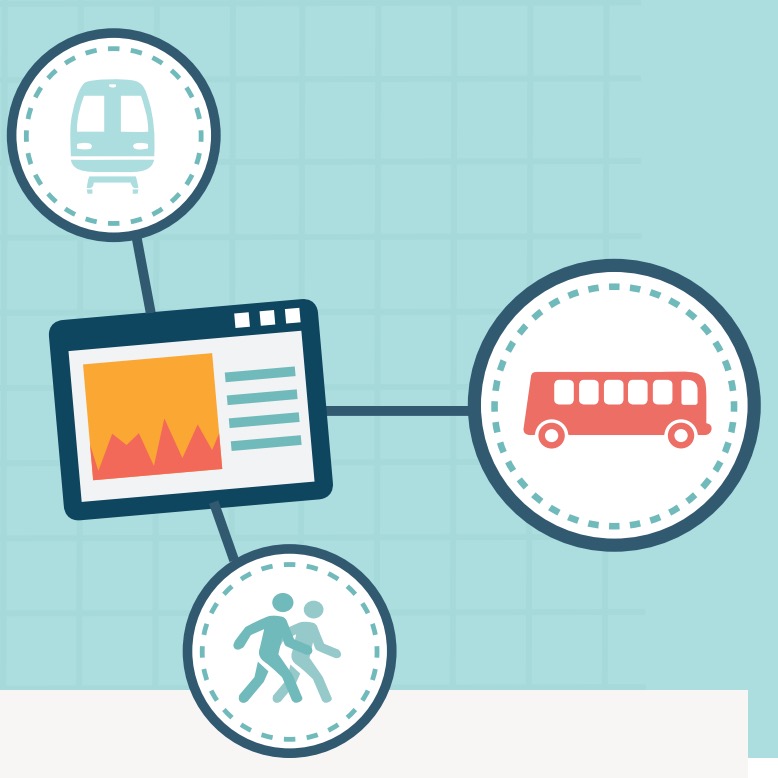TRANSPORTATION FOR AMERICA
How Metropolitan Planning Organizations Across the United States Use Performance Measures
Summary
 Performance measures for transportation are coming, one way or another, thanks to new federal requirements created by Congress in MAP-21, the federal transportation law enacted in 2012. That law ushered in a new era by requiring metropolitan planning organizations (MPOs) to start evaluating the performance of their transportation investments against a handful of federally required measures.
Performance measures for transportation are coming, one way or another, thanks to new federal requirements created by Congress in MAP-21, the federal transportation law enacted in 2012. That law ushered in a new era by requiring metropolitan planning organizations (MPOs) to start evaluating the performance of their transportation investments against a handful of federally required measures.
Some metro areas have already been using performance measurement for years, going far beyond the federal government’s modest new requirements (such as safety or condition of roads & bridges) to assess their transportation investments in terms of more ambitious goals like return on investment, public health and access to jobs. With the new suite of measures finalized by USDOT in 2017, it’s no longer an option for MPOs — it’s now a requirement.
Knowing this, T4America conducted a national survey of 104 MPOs from 42 states to find answers to some key questions and establish the current state of the practice:
- How many MPOs are already using performance measures in some form?
- How many are interested in going beyond the new modest federal measures?
- What’s keeping them from doing more?
- What other key goals and metrics are they interested in measuring?
Among a range of interesting findings, we discovered that the majority of the MPOs surveyed (75 percent) are already using performance measures in some fashion. However, there is significant room for improvement in how they use them — only 30 percent of all MPOs utilize performance measures to evaluate specific projects for inclusion in the fiscally constrained five-year plans that govern all short-term spending.
While most MPOs are focused on meeting the new federal requirements, two-thirds of all agencies surveyed also want to become national leaders in using performance measures — including many MPOs currently doing only the minimum or just getting started.
When it comes to additional measures outside of MAP-21’s modest new requirements, nearly half of MPOs surveyed chose equity and/or health as one of the five additional goals they are interested in measuring and assessing.
Are MPOs using performance measures?
Performance measures have tremendous power not only to better prioritize investment, but also to build the trust of taxpayers by increasing transparency and accountability. More confidence that existing money is being spent well can help make the case to voters for additional revenue. Overall, transportation planning was already becoming more data-driven, but these new federal requirements mark a shift from the old era to the new.
Are MPOs ready? How do they use performance measures now? How many are ahead of the curve?
- Most, but not all, MPOs are currently using performance measures in some fashion. Only 25 percent of MPOs surveyed (26 out of 104) did not use performance measures at all in either their last long-range or constrained short-term planning documents. (The Long Range Transportation Plan or State Transportation Improvement Program/Transportation Improvement Program.)
- Both large and small metro areas are sitting on the sidelines, suggesting that size or capacity aren’t the only reasons MPOs don’t use performance measurement. It’s a common perception that the only MPOs not using performance measures are small ones due to a lack of resources or expertise. Yet 50 percent of the MPOs that did not use performance measures in their last LRTP/TIP were in areas of at least 500,000 in population. This suggests that other factors like organizational culture, preference, governance or the influence of an MPO’s board may be involved.
How are MPOs using performance measures?
There are many different ways to develop and implement performance measures, and our survey found significant variation in how MPOs currently apply them. As expected, most are focused on the new federal measures rolling out over the course of 2017. But there’s significant room for improvement in actually using measures to determine which projects to build to help them meet their goals.
- MPOs are most focused on the new limited range of measures required by MAP-21. When asked about the five specific areas MPOs would be most interested in exploring out of ten available options in the survey, MPOs chose (in order of preference) 1) transportation safety, 2) transportation system performance, 3) economic growth and competitiveness, 4) access to jobs and opportunity and 5) freight movement — most of which are included in some fashion in the just-released final requirements from USDOT that were created by the 2012 MAP-21 legislation.
- Performance measures are most often used for broader, big-picture long-range planning, and far less for evaluating specific projects. While 75 percent of the MPOs surveyed (78 of 104) used performance measures in some fashion in their last long-range plan, only 45 of those 78 did so to explicitly select which projects to include. And only 32 of those 78 went a step further to also use measures to influence which specific projects are chosen for inclusion in the five-year plans that govern all short-term spending.
- MPOs are more likely to use performance measures to evaluate current conditions — less likely to use them for selecting which projects to fund to improve those conditions. 65 of those 78 MPOs that use performance measures said they use performance measures to evaluate current conditions and needs, yet as the previous point shows, a much smaller percentage of MPOs are also using them to choose projects for their long-range planning documents or their more binding short-term project lists.
Download full version (PDF): Transportation Performance Measures
About Transportation for America
t4america.org
Transportation for America is an alliance of elected, business and civic leaders from communities across the country, united to ensure that states and the federal government step up to invest in smart, homegrown, locally-driven transportation solutions. These are the investments that hold the key to our future economic prosperity.
Tags: Metropolitan Planning Organization, MPOs, survey, T4America, Transportation for America







 RSS Feed
RSS Feed